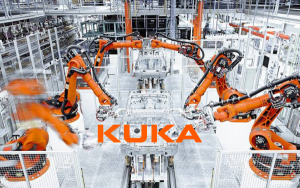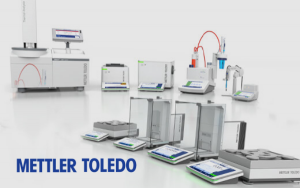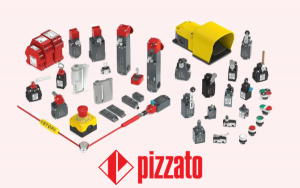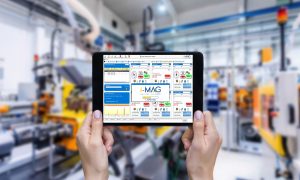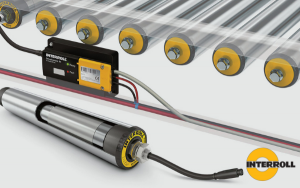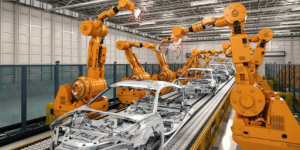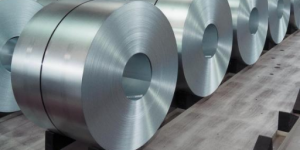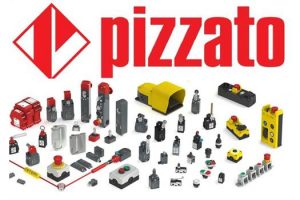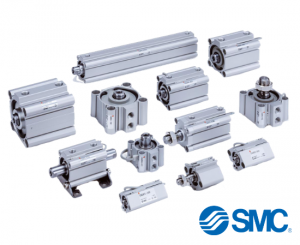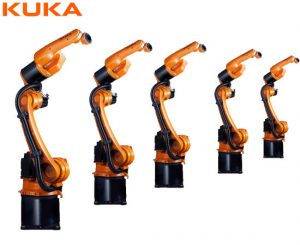Lean Manufacturing or Lean Production both mean lean production. Lean Manufacturing helps businesses tackle one of the worst things that can happen to any business: waste. When a business does not make full use of its resources, it will lose efficiency, leading to production stagnation. These neglected resources include everything from production management to employee skills.
Of course, the industry is rife with waste (collectively, waste), whether it’s idle workers or unused materials that cannot be recycled or reused become a drag on the industry. with the production capacity of the enterprise.
See also: Downtime in Production – What is Downtime?
I. Lean Manufacturing – What is Lean Manufacturing?
Lean manufacturing is a production system that focuses on reducing waste, creating value for customers, and seeking continuous process improvement. This is achieved by applying lean project management principles, techniques and tools. Lean methodology was first implemented in the Toyota Production System (TPS), which revolutionized the company’s manufacturing process.

II. Lean manufacturing principles – lean production
Here are five lean management principles applied to optimize lean production systems:
1. Value: Before starting to identify and eliminate waste, businesses need to determine what is valuable to customers. Once the customer determines what is valuable to them, the business can create a product that has only what is needed and removes all the unnecessary work and components associated with it.
2. Value Stream Map: Value stream mapping allows managers to visualize each step in the production process to identify waste and improvement opportunities.
3. Flow Creation: One of the goals of lean manufacturing is process improvement. That’s because an improved step in the value stream, businesses can reduce their production time.
4. Pulling system: Pulling system includes starting a new job when there is a need of the customer. This is what supports just-in-time production.
5. Continual improvement: This lean principle includes the continual use of lean techniques such as value stream mapping to find and eliminate waste.
It is through these principles that lean manufacturing improves production systems. Lean Manufacturing helps to simplify the operational structure to understand, implement and manage the work environment. To do all of this at once, Toyota adopts a mentoring method known as Senpai and Kohai, meaning senior and subordinate. This promotes lean thinking throughout the organizational structure from the team upwards.
III. Types of waste in lean manufacturing process
Waste is not a simple concept in lean management. For lean project management to be most effective, all types of waste must be identified and eliminated. We will go over eight types of waste in lean management.
First, let’s take a look at seven lean manufacturing wastes developed by Taiichi Ohno, Toyota’s chief engineer, for the Toyota Production System (TPS).
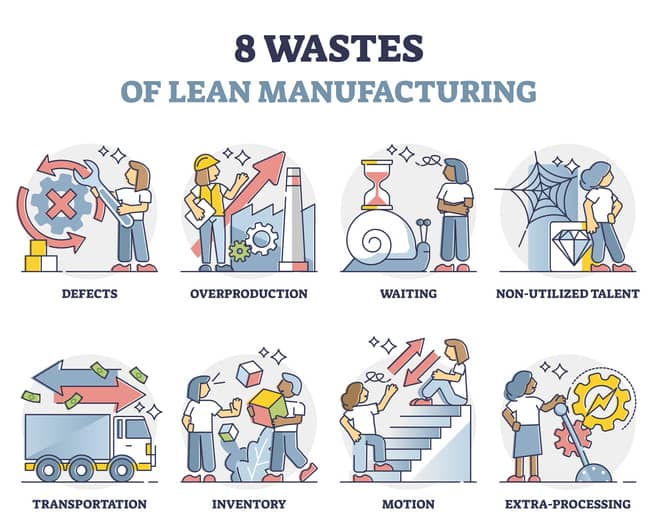
1. Non-essential shipping: Unnecessary transportation of staff, tools, materials or equipment is waste that needs to be eliminated by optimizing the plant layout.
2. Excess Inventory: Having excess inventory can lead to a number of problems such as failure to identify defective products in time or increase lead time in the production process, among others. .
3. Unnecessary movement of people, equipment or machines: This waste is eliminated by applying scientific management techniques to optimize the movement that people, equipment or machines make. present during production.
4. Waiting (Idle Worker or Idle Equipment): This type of waste occurs when employees cannot work because they are waiting for materials or equipment, or in the opposite case, there may be inactive equipment pending maintenance.
5. Overproduction: Overproduction leads to excess inventory and other problems in the production process. That’s why lean manufacturing adopts just-in-time manufacturing, which involves producing only what the customer requires.
6. Overworking: This waste includes adding components or features to the product that the customer did not require, which makes them unnecessary.
7. Defects: Having a defective product, it is a waste that must be minimized as much as possible. They can affect customer satisfaction and increase costs.
In addition to these types of waste, lean manufacturing experts have suggested an eighth type of waste known as “unused talent or ingenuity”, which occurs when workers’ opinions are not are taken into account when identifying waste types and improving production processes. Their feedback is important because they encounter problems on a daily basis, and their thoughts can be very helpful in the value stream mapping process.
To simplify things and make it easier to understand, these waste types can be grouped into 3 broader categories.
Mura: Uneven, or wasteful due to fluctuations in demand. This may stem from a customer request, but may also result from an organization adding new services and thus additional work.
Muri: Overloaded, or wasted by trying to do too many things at once. This is related to resource allocation . When too few people try to do too much, they often waste time switching from one task to another.
Muda: The work does not add value or the process is wasteful. This waste comes in as a by-product of something else. Think of three things: value, work that delivers instant value to the customer; necessary waste, which are activities that support value-added; and unnecessary waste, activities that do not add value. Thus, Lean maximizes value, minimizes necessary waste, and completely eliminates unnecessary waste.
IV. Lean Manufacturing tools – lean production:
To apply lean principles to your manufacturing process, you’ll need a lean manufacturing toolkit to help you identify and eliminate waste. That waste can be created through overloaded and uneven workloads. Eliminating waste from any production system improves production quality and time while reducing costs.
Some lean management tools include:
- SMED (one-minute mold exchange, a quick way to switch from one manufacturing process to another)
- Value Stream Mapping (A value stream map allows managers to visualize each step of the manufacturing process to identify process improvement opportunities)
- 5S (a workplace organization method)
- Kanban board (shows workflow)
- Poka-yoke (error resistant)
- Total productivity maintenance (improving the integrity and quality of the manufacturing process)
- Sorting by order of rank (production flow analysis)
- One point scheduling
- Redesign work cells
- Handle multiple processes
- Control chart (for workload testing)
Other ways to approach lean manufacturing are just-in-time manufacturing or the Toyota Way, as it was developed by the company for the well-known Toyota production system. Here, the focus is on improving the workflow to eliminate unevenness rather than waste. Kanban boards are essential for this type of lean management.
The goals for both approaches are the same, but the means to achieve them are slightly different. According to the Toyota Way, improving the production process is the goal, but in doing so waste is also naturally eliminated. Proponents of this manufacturing process argue that it takes a system-wide perspective as opposed to a lean manufacturing system that focuses solely on eliminating waste.

The benefits of lean manufacturing:
Reducing or eliminating waste is essential for lean project management, but the benefits of lean manufacturing can vary depending on the audience in question. Some say it is increasing the company’s profits while others maintain its improvements are just to create customer value and increase customer satisfaction. Here are some common goals.
- Improve quality: To stay competitive, companies cannot be complacent, but must respond to the changing wants and needs of customers. Therefore, processes must be designed to meet their expectations and requirements. The application of total quality management can make quality improvement a priority.
- Inventory management: Thanks to just-in-time manufacturing, lean manufacturing reduces excess inventory, helps reduce costs, and prevents production problems.
- Process improvement: Lean production system is always improved thanks to the lean principle of “continuous improvement”. Value stream mapping is essential for this.
- Eliminate Waste: Waste is harmful to costs, deadlines and resources. It takes without adding any value to a product or service. By eliminating waste, lean manufacturing systems can produce better products, at lower costs.
- Reduce Time: Time is money, as the saying goes, and wasting time is wasting money. This is especially true for the manufacturing industry. Reducing the time to start and finish a project creates value by increasing efficiency. Learn and apply some time management strategies .
- Reduce Total Costs: Save money as the company does not waste time, materials and personnel on unnecessary activities. Overproduction also adds to storage and warehousing costs. Understanding the triple constraint is the first step to understanding cost management.
In short, the goal of Lean Manufacturing is to aim: with the same output but with lower inputs – less time, less space, less labor, less machines, less materials. more materials and less cost.






